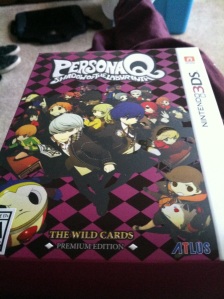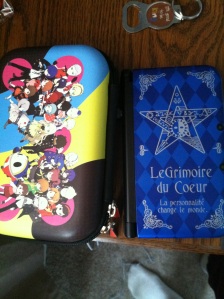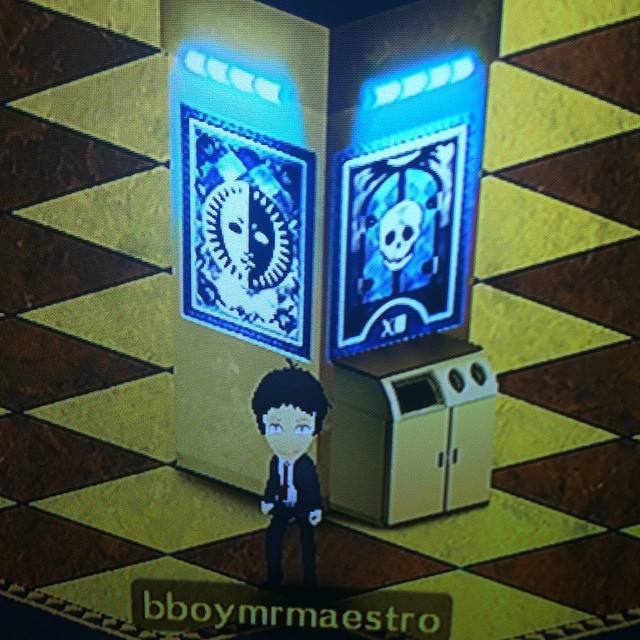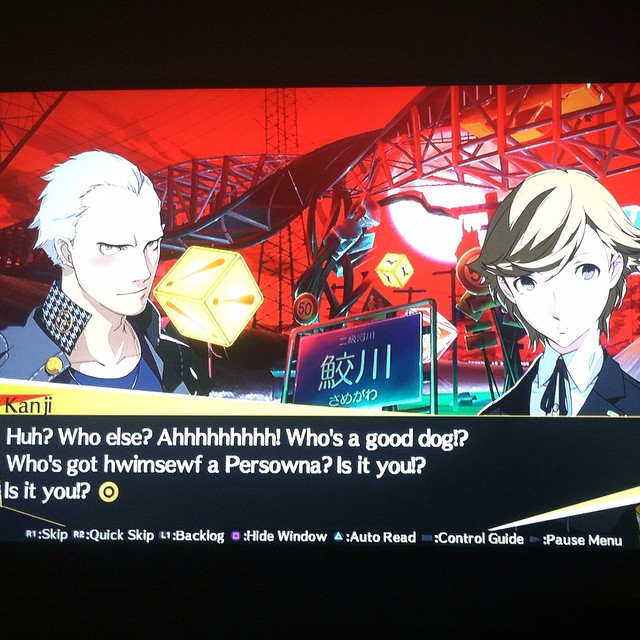Original post date: 25/11/2014
Hi!
I recently bought a brand new 3DS and copy of Persona Q: Shadow of the Labyrinth on launch and promptly sunk about 4 hours in. I would like to make a review in progress over the next few, as it may take a great amount of time to finish this game.
From the opening sequence, the P Studio has nailed making a Persona game in appearance and aesthetic; from the rocking intro to the serene start screen, everything looks and feels like a main numbered title. So far, the art style has been delightful, as familiar characters have been made into smaller, cuter models that still retain their original attitudes and facial expressions. In the first few cutscenes, the new voice acting is slightly different, but just like Golden and Arena, Atlus has chosen perfect new talent to cover the dubs. In my review for Ultimax, I made a note of criticizing the corners that the characters from both games were written into, becoming a bit flat given the different medium. In an RPG like PQ however, everything you know and love about these characters is able to be fleshed out; plenty of pitch perfect interactions and reactions from Junpei, Aigis and new to the series Ren & Zei flavor the cut scenes and in-game dialogue like a classic Persona game (For this review, I chose the Persona 3 side for the intro, however, at some point the 3 & 4 cast will collide and make one story line). From what I’ve seen, even the dungeons and enemies are borrowed and tooled towards 3 a little more, with plenty of classic Shadows returning, albeit tuned more for this battle system.
The dungeon crawling and map making lifted from the Etrian Odyssey series work amazingly well, and for a series rookie like myself, are easy enough to learn and use. I had worried about having to maintain the map and how different the dungeons would feel, but the combat reminds me enough of old MegaTen games, and works well for me. The one thing of note about this round of dungeons, either because of me or the size of the layout, it has taken me 3-4 hours to get to the third floor of the dungeon. Compared to the relatively fast nature of mainline Persona games, this is a snail’s pace. But, combat is engaging enough and there’s plenty on the map, from shortcuts to traps to treasure to ensure this by no means a boring long haul. FOEs (again, borrowed from EO) act more like the Shadows we are used to, being visible on the map and in constant motion, but keep a set path and are extremely, butt-clinching hard. Most will be able to kill party members in one swing, so avoid them at the beginning.
In my few hours, the item shop and Velvet Room have returned as primary sources for items and Persona respectively, and a for-profit clinic run by Elizabeth has been set up to heal and restore SP. A good mix of familiar elements and new mechanics means I am able to balance healing, item synthesis and purchase, and Persona fusion in a similar manner to my usual method.
Persona usage, in fact has been changed for this title, allowing all party members to carry a sub-Persona tacked on to their prime Persona. This eschews the usual battle method of relying on your main characters 12 slots of Persona switching and spreads that responsibility to the whole team. It’s been interesting and fun to try to get the perfect team of Persona matched to my party members, in order to cover weaknesses, add more elements to my repertoire, and try new moves and strategies. It’s also been a pain in the ass to try and remember to equip new Persona each time I fuse new ones or receive them in the field, but that’s more to blame on my slept deprived brain than anything.
I’m gonna check back in when the two parties collide (spoilers, I suppose), which may be anywhere from a few hours to a few days depending on how much more this first dungeon will take me. All I know is, if I had to review this game for scale, I’d be a little late out of the gate, even if I got a review copy! And that’s not a bad thing in my books.
~M.
26/11/2014 03:44 A.M.
EDIT: As of this moment, I completed the first dungeon, in game clock stating six hours and 55 minutes. Given, a lot of that time was soaking in cutscenes and interactions in the dungeon, if this is a sign of things to come I’m possibly looking at a 40+ hour session.
For a first dungeon, it had just enough to offer for variety sake; the trap doors went from simple mechanic to puzzle piece over floors, which added a level of strategy to movement. As well, the dungeon boss had some good lead up and was just challenging enough to keep me on my toes.
And on the subject of lead up, the big reveal of the Investigation Team a la Persona 4 may be my hypest game moment of the year. It was perfectly executed from the inclusion of P4’s Reach out to the Truth to the amazing JoJo poses the team struck (and the explanation as to why they did it soon after). I had hoped something this momentous would be exciting for me, and as a fan of the series, this was one of the best moments in recent Persona history. Instead of the gradual revelation that occurred in Arena’s story, this hits you over the head and doesn’t apologize, which pays off in sheer excitement. The remaining hour of my play session was sitting back and watching these two teams mingle and interact, quickly becoming one giant, mushy package. Atlus knows how to serve up 5 star fan service.
27/11/2014 1:46 A.M
Day 3 of play and I’m well into the second dungeon with a few new mechanics built in, from sliding floors to sub-bosses. This dungeon in particular has a great theme going for it, playing off the Group Date Cafe from Persona 4. I’m gonna avoid spoilers as best as I can but the possibility of these characters reaching their “destined partners” like the PA system in this dungeon has been pressing for is going to be hilarious. It’s good on the directors to really theme there dungeons out with not only a wide variety of floor gimmicks, but also themes that are both very easy to pick up on and worth really studying as you go along. I’ve had my first few frustrating moments at a checkpoint sub boss that killed my party a few times. Grinding is now a necessity but unlike most dungeon crawlers, it’s worth the extra time. Between leveling up, getting materials and finding hidden treasures are all rewards for your time. I was worried this would repeat the problem Conception II ended up having by not adding enough variety between labyrinths, but I’ve yet to get that same lethargic feeling I got halfway through Conception. I said earlier this will be a long session. At least it’s going to be a fun one.
29/11/2014 Game clock reads 21 hours and 48 minutes
Trying to balance hosting the parents, work and reviewing this game put a slight hold on my efforts, if anything it slowed my progress. But after 9 hours, I’m done with the second dungeon, and wow there’s plenty of material to cover. The whole motif allowed for a good chunk of fan service and themes worth talking about, mostly to do with love and romance in the Persona games. Dating mechanics have always been integral since the inclusion of Social Links in 3, and some of the most positive fan reactions come from how well these relationships play out on screen. Starting with already well written and liked characters and making them naturally become friends and eventually more has been a hallmark of the series, despite the possibility of making a harem and watering down the whole experience (which in most cases, comes back to bite you in the ass later, i.e. P4G’s Valentine’s Day sadness or getting caught cheating in either game). This was touched on plenty with the Group Date cafe dungeon, even calling back to the original group date and setting up a new one for your team, which played out predictably hilarious. Between some doors were questions laid out for the player about desirable aspects of a partner, ranging from age, activities and ideologies. They covered plenty of ground, and never punished or ridiculed you for answering, even on topics like preferred gender of your partner. I’m not going to flesh this out anymore as I really want people to experience it themselves relatively spoiler free, but the results were phenomenal, classic payoff. The final boss also had some interesting tactics, punishing players for doing certain actions each turn, really requiring you to think about how you’re going to tackle a round and listen to its cues. Again, this game builds off the last dungeon and keeps you on your toes, my only complaint is the pacing. 9…hours! I’m okay with dungeons taking some time, but I can’t recommend this game to people with short attention spans or no patience, because it takes plenty to navigate this game. so far, that’s my only big negative bulletpoint, and nothing short of catastrophic failure will make this game a solid recommendation to fans of Persona, Etrian Odyssey or JRPGs in general.




